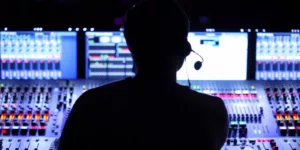Whether you teach college courses or create sales pitches for potential new clients, using the best audiovisual technology can help make your presentation more memorable. Audio and visual technology has boomed in recent years, becoming impressively more efficient at the same time that it has improved overall performance.
Price points on many forms of technology, from projection units to sound systems, have also become more affordable. The result is that you may have many more options for giving a stunning presentation then you did in the past. Capitalizing on some of the hottest trends this year and next year will help make what you have to say more memorable for your audience.
10. Extremely High Resolution
Long gone are the days of mediocre projections that were grainy and blurry. Modern screens have hundreds of pixels per inch, creating lifelike detail even on massive scales. Embracing high-resolution images is a great way to visually draw your audience into the presentation. If you can’t afford cutting-edge technology, you might consider outsourcing event company services, as the business you partner with can likely connect you with better technology.
9. Laser Projection
Speaking of image quality, laser projection systems offer incredible accuracy when compared with older systems. Unlike older lamp-based projection systems, modern laser projection systems use low-heat lights and less energy than traditional projection systems.
As a bonus, these systems often last 10 times longer than they older systems before requiring replacement parts. They can also be useful for projection mapping, which is a hot element to integrate into your audiovisual presentation right now.
8. Help from Artificial Intelligence Assistants
Is there anything more obnoxious than needing to interrupt your presentation to call a volunteer from the audience to turn off the lights? More presenters than ever before are integrating AI assistants into their presentation performances.
Provided that you have smart systems in place where you are giving the presentation, you can control everything from the lighting to the volume of your audiovisual presentation through an AI assistant.
7. Interactive Visual Programs
Whether you require audience members to vote on an issue or perhaps have them execute a quiz at the end of the presentation, interactivity is a great way to maximize audience memory retention and determine what areas of the presentation were unclear to the audience.
Interactivity can be done in a number of ways, from live voting on a Facebook poll to the use of a proprietary app that works with your presentation.
6. Specialized Apps for Presentations
Creating an app is complicated, but it can also be of great benefit for those who routinely use the same presentation. Developing a specialized app that contains the bullet points for your presentation, as well as resources and citations, can help your audience access information long after your presentation ends. The investment of time and potential outsourcing required to create an app is offset by the many benefits that come from integrating a proprietary app into your presentation.
5. Integrating Virtual Reality/Augmented Reality Technology
Plenty of people have virtual reality headsets, and quite a few use augmented reality systems, such as Google Glass. You can actually integrate these systems into your presentation. Their use can be optional, allowing users to bring their own equipment.
If it is a smaller presentation or an event at a location that can provide equipment, you may be able to provide headsets and resources for the audience. Immersing your audience in augmented or virtual reality scenarios is a great way to make the information that you share highly memorable.
4. Accessibility as a Major Focus
For many years, presentations and group educational opportunities overlooked the needs of those with disabilities, such as hearing impairments or difficulty reading. Modern technology makes it much easier for presenters and educators to integrate those with disabilities into a presentation.
From providing audio tracks that describe the videos presented to subtitles for spoken language, there are many opportunities for accessibility. Integrating these into your presentation will benefit those of your audience who need those efforts and encourage others to do the same in the future.
3. Audience Using Its Own Screens
It may be possible to design a system that works with your audiences’ screens, provided that you plan for people using both Android and Apple systems.
Whether you provide a link to a Google document that each member can access in real time or videos uploaded to an online host site, allowing audience members to use their own screens, such as cell phones or tablets, can keep people from using those screens to distract themselves from the presentation. It can also make people feel more engaged and included as the presentation moves forward.
2. 4D Presentations with Water, Fans, Etc
While you may not intend to use 3D graphics in your presentation, using 4D elements could be very engaging for your audience. 4D theaters often take advantage of environmental tricks, such as spraying water, generating fog, or adjusting the temperature in the room for a surprise effect. Using one or two 4D effects as part of your presentation can definitely increase audience engagement and how well they remember what you present to them.
1. Live Video Streaming
Not everybody who feels passionately about the topic on which you are presenting will have the ability to attend in person. Integrating live video streaming options into your presentation and presenting that option online on social media and your own website is a great way to reach a broader audience. It also makes your presentation accessible to those who have health conditions that preclude them from attending the event.
Learning the newest and most exciting audio and visual trends for 2019 can help your presentation stand out. You don’t need to integrate all ten of these trends, as any one of them will be enough to surprise and engage your audience. Spend some time thinking about your subject matter before you commit to the most appropriate trends given what you will be using audio and visual technology for this upcoming year.








